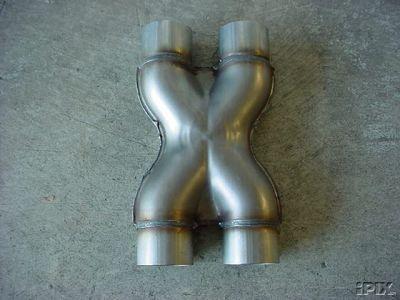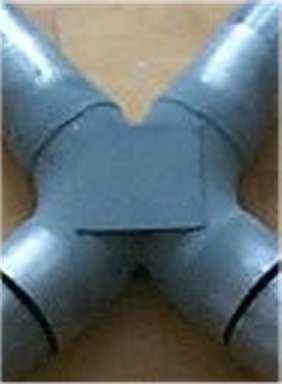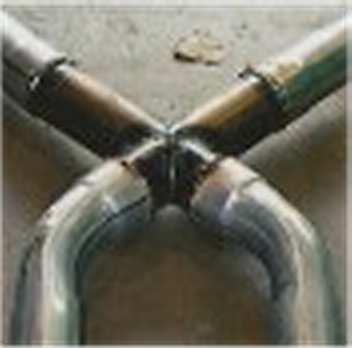
Moparts Tech Archive
Exhaust
Place to get an X-pipe
XX340Moparts Member
Posts: 280
From: Fayetteville N.C.
Registered: Feb 2002
posted 07-04-2002 06:14 PM
I've decided to put an X crossover on my 67 Barracuda. The car has a 383 with the TTI headers.Thanks
============================================
Fury_Us
Moparts Member
Posts: 744
From: OKC, OK
Registered: Jan 2002
posted 07-04-2002 06:26 PM
I'm not sure if anyone makes them for specific applications--I thought it was more of a custom deal--you buy the X and make it fit your system.
=============================================
mprmdness
Moparts Member
Posts: 202
From: garden grove calif
Registered: Jan 2002
posted 07-04-2002 06:42 PM
muffler shop made mine
=============================================
rvoyles
Moparts Member
Posts: 1515
From: Bakersfield, CA.
Registered: Aug 2000
posted 07-04-2002 06:42 PM
Magnaflow makes one too (pic below).
It doesn't look like it works like the dr.gas unit to me.

=============================================
Fish67
Moparts Member
Posts: 2401
From: Columbus, OH
Registered: Jun 2001
posted 07-04-2002 07:31 PM
Can some one tell me the pros and cons to the x pipes?
============================================
Keefe
Moparts Member
Posts: 157
From: lexington park Md
Registered: Jan 2001
posted 07-04-2002 08:14 PM
Fish67...if you want the best performance wise get a, Dr gass setup. I strongly advise you to call Dr gass and talk to them,you will be suprised at how you can make max power and keep the car quiet,it aint cheap thou...
I had several phone conversations with them and really was sceptical on the setups but then I saw Brad H go 10.90's very quietly with a 3 inch dr gass set up with 2 1/2 inch tail pipes and no name mufflers,I was sold.
I now have a 3 1/2 inch set up with 3 1/2 3 chamber flowmasters with 3 inch tail pipes my 440 duster is quiet and goes 11.0s... If you do get a x pipe built by a shop get one that deals with dr gas they have the x pipe measurments that work..
============================================
VanishPt
Moparts Member
Posts: 1074
From: Midlothian VA
Registered: Nov 1999
posted 07-05-2002 04:02 PM
Had an h pipe set up using 3 inch with 16" UltraFlow's under the rear seat and 16x6" round UltraFlows by the gas tank. At idle you would hear a little bit of a "phit,phit" sound, kinda of an erratic pressure sound.
Put on a Dr Gas this am., 3.5" into the x and then 3" to the mufflers. The idle is now quieter with no "phit,phit" sound. At highway speed , it has a deeper tone sneaking in through the window. When I open it up, you can hear more of the "4 bbl sucking air" sound. No performance info ....yet!
A little tid bit of info for you e body guys. If you use the Dynamax 3" mufflers for an e body ( the ones that are 14" long) The inside pipe is only 2.5", a 16" is the shortest one that has 3" all the way through.
=============================================
440 Jim
Moparts Member
Posts: 2372
From: Lexington Park Maryland
Registered: Jun 2000
posted 07-05-2002 10:38 PM
Good feedback.
I have a 3" X-pipe on my 440 Barracuda. It had an H-pipe (2.25"). I have heard, and have people tell me, that some X-pipes sound like V-6 cars, etc. But my car doesn't sound that way. In fact, my x-pipe and mufflers came off of BradH's 440 Challenger and Keefe says my car sounds different than Brad's used to! Maybe it is the tail pipes and the way the tips exit (different on 'Cuda and Challenger). Or maybe just the cam...
============================================
info provided by members listed above
<
Tim Moffett
Moparts Member
Posts: 1627
From: Rochester, NY
Registered: May 2000
posted 05-20-2002 08:19 AM
First off, no offense to RKeesler, who took the initiative to make a cheaper x-pipe...
There is a fundamental difference between the x-pipes on the market and the one tested.
The above "X" completely merges exhaust gasses, forcing them to share an intersection that has less volume capacity than the entering gas 'requires'.
The biggest mistake one can make is to restrict exhaust flow in the first few feet of the exhaust system, where the gasses are very hot and very expanded. That is why mufflers are less and less restrictive the farther back they are located (sorry if I am stating the obvious).
The images below show the difference between the Dr. Gas and RKeesler X's.
Also, bends in the exhaust system equal friction, which equals restriction in flow (the closer to the primary tubes, the more this this is a factor).
And...
"The primary tubes certainly don't begin at the same place - 1 side is always longer by several inches. "
Not in a good set of headers!
Dr gas 'X'

========================================
Keesler 'X'

========================================
Here's some info from the Dr. Gas site:
STEFF
Moparts Member
Posts: 1937
From: ARMADA, MI. USA
Registered: Apr 2000
quote:
Remember that radio and TV commercial about the piston engine going "Boing-Boing," when it out to go HUMM? Well, all V8 engines with 90 degree cranks, have an out of sync imbalance in their firing order between the right and left cylinder banks. Yes, they do go "Boing-Boing." The firing order imbalance is a necessary sacrifice for dynamic balance of the rotating and reciprocating crank, rods and pistons. Each time the firing order is completed (two full revolutional), two cylinders within each bank will fire and exhaust within 90 degrees of each other. These two cylinders will be exhausting into the header collector or exhaust manifold almost simultaneously. This overlapping condition creates a lot of back pressure and a pop sound. Meanwhile, the opposite exhaust manifold has no activity (or pressure) in it at all. This is where the characteristic, low harsh popping V8 sound comes from.The most common way of reducing this out of sync imbalance is with rebalancing crossovers such as H pipes and over-and-under X style crossovers. These provide both noise reductions and efficiency (power) improvements. H pipes are effective only at low and mid range. The over-and-under X crossover works a little better but still does not completely rebalance the exhaust at high RPM.
Dr. Gas, Inc. has developed a new generation of crossovers that uses a tangentially siamsed junction, in place of the H or over-and-under X. It evenly splits, smoothes, and synchronizes exhaust pressures at all engine speeds. The high and low pressure pulses in the two pipes are evenly imposed on each other, leveling out the pulse time history pressure differences between right and left cylinder banks. Re-synchronizing the exhaust pulses reduces back pressure, cancels sound, and provides additional scavaging. Tests have sound 6 dBa (75%) reduction in sound levels, and increases of 10 to 30 hp, and up to 40 ft-lbs. of torque! Economy, and throttle response are improved. Exhaust flow after the crossover is completely smoothed out. The job the headers started is finished.
One of the most appealing benefits of this system is the modified exhaust note. The deep growling and popping sound is replaced by a higher pitched smooth sound. The exhaust note is similar to a 180 degree header system without the nightmare of tubing.
Dr. Gas crossover kits replace the first 3 to 4 feet of the exhaust system with pre-bent mandrels pieces. Simply measure, cut and weld into place. The system is universal fit for most header applications. After the crossover, any type of dual exhaust, converters, or mufflers may be used with little or no effect on power. Vehicles that have problems meeting sound limits at local area tracks can also benefit with an increase in power tool. And so, the piston engine can go HUMM!
===========================================
Darvin
Moparts Member
Posts: 1100
From: Silicon Valley, CA
Registered: Nov 1999
posted 05-19-2002 01:16 PM
Seems to me an "H" pipe would help any exhaust system with pipes too small or mufflers too restrictive. Once you get past that problem, seems an "X" pipe similar to the DrX product would enhance scavenging the same way a collector does on long tube headers. I think a Pontiac guy has already done some extensive testing on this and has a web site.
As far as bends are concerned, you don't necessarily slow down the exhaust with bends. I know the signal generated by the engine plays an important role in moving the exhaust. I suspect both the signal from the engine and the actual exhaust act much like a light signal in a fiber optic cable where the loss can be reduced to near nothing if you control the minimum radius. Electrical signals work the same way. I'm sure there are other or better examples but that's the idea.
I can't imagine how adding a restrictor to a system could help but who knows Something to ponder.
=========================================
dbdartman
Moparts
Posts: 3981
From: Trenton, NJ
Registered: Nov 1999
posted 05-19-2002 06:24 PM
I made my own X-pipe. It's 2 pieces of 2.5" pipe each bent @ 45°. I cut the back of the bends with a chop saw leaving an opening of about 4-5" long & about 1.75" tall & welded them together. This is installed behind my home-made tri-Y headers (1.5"/2"/2.5") & ahead of Magna-Flow mufflers AND resonators in the tail pipes. The 360 has a very deep & mellow tone to it (most would consider it quiet!). Maybe I did something wrong, but it sure doesn't sound "funny" to me, or anyone that's hear it. Matter of fact, most say it sounds like a big block! It's not just my Dart either. My bro's 68 B'cuda has the same style exhaust (tri-Y's, X, Magna-Flow look-alikes, & resonators) & sounds the same (quiet, deep rumble).
Hey, I don't claim to understand it, but there are members here that will attest to it's sound (Craig, Pete, wingcars, Alan, c-m-clone, etc).
DB
==========================================
panic
Moparts Member
Posts: 1949
From: New York
Registered: Nov 1999
posted 05-19-2002 10:34 PM
If memory serves, a careful test of an "H" showed almost no actual volume of gas passing across to the other side, so the concept of "shared" muffler capacity is not the answer. What's left is the sonic resonance concept (as expressed so well by steff) that the pulses can echo back to the opposite bank for better scavenging.
What Darvin says is true, also: sound waves are sensitive to changes in cross-section, but not bends, and happily follow a very small radius without loss of strength. A reduced cross-section (if gradual) has only minor effect, but a large change in area is seen as another point of relection, and generates its own wave pulse.
I think another factor is placement - why would the entry point of both sides of either an "X" or "H" be exactly opposite each other on the car? The primary tubes certainly don't begin at the same place - 1 side is always longer by several inches. This might cause a well-designed system not to function as predicted, and accidentally favor 1 with lesser credentials.
Testing is the answer!
========================================

Tech Index